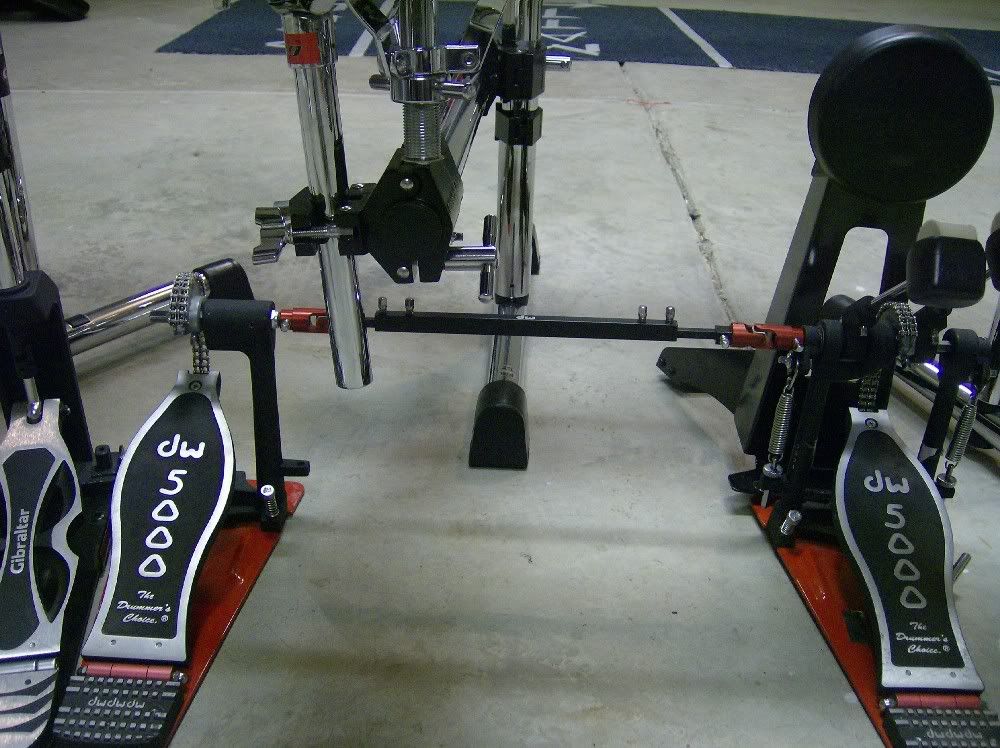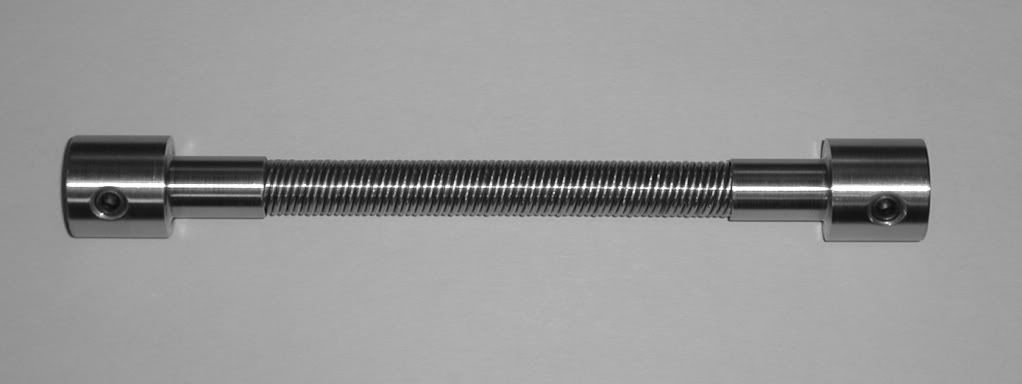I don't know the answer. But, it's a great question.
Probably the design paradigm is for a shaft, or torque tube, so that's what they use. It's simple, cheap, and does the job.
I think a flexible shaft would be a good innovation.
I got my first double pedal set up yesterday and noticed immediately what problems may develop with such a design. I'm sure all double pedals use the design of a rigid, tubular connecting drive shaft with extension coupling rods at either end. Myself, I could use another couple of inches of extension and am more comfortable with my left foot closer to me( at a greater angle to the right foot pedal.) So I figure the coupling joints at either end will slowly wear as the drive shaft extensions begin "the slow twist of death" and eventually break or warp. But...cheap as they are, my footboards are so thick so as to put my Speedkings to shame.
So why not develop flexible drive shafts? Every power tool maker has them so it's not like a new idea. Then you'd never have the shafts break or the joints at either end wear out.
Anybody here know why a flexible cable wouldn't work?
Last edited by slinglander; 12-02-2010 at 09:34 PM. Reason: added text
I don't know the answer. But, it's a great question.
Probably the design paradigm is for a shaft, or torque tube, so that's what they use. It's simple, cheap, and does the job.
I think a flexible shaft would be a good innovation.
Pedal Latency? Possible extra friction? Or just the same reason they don't use flexible drive shafts for everything, it's more expensive.
The only two constants I have are DW and Zildjian.
A flexiable shaft? Really? I can't see how that would help pedal set up? Maybe I'm misunderstanding where the shaft will "flex"? Flex as in being able to twist horizontally as the pedal moves back and forth or "bendable" where you could "curve" the connecting rod for better floor placement?

You're lucky, Late8: your pedals are parallel( but then I don't see a snare in the way). So your connecting drive shaft joints aren't at an angle to your pedal shafts.
When I play my feet form a "V" with the snare in the middle, my throne at the point/apex of the "V." Any time you see a double bass set up, they're angled, for the same reason.
My point is a flexi cable connecting the two pedals would allow for all kinds of playing/sitting positions.
Hes playing electric ^^snare free float lol but I don't see why it wouldn't work as long as you get a flex tube that wouldn't twist but be able to bend without throwing your pedals around, I think that would be the hard part, finding a tube that is flexible enough to do what you want but not so flexible that it would just twist in two if you were trying to do fast beats with your pedals..
Something like this may work, longer obviously. I don't know what the feel would be like, once you put a bend or curve on that shaft. And, being rigid like this would take away the adjustment of the shaft, as far as length. Interesting idea though. I'm sure there are much bigger brains than mine that could make it work.
L

That's what I'm talking about!
[QUOTE=Linchpin;339476]Something like this may work, longer obviously. I don't know what the feel would be like, once you put a bend or curve on that shaft. And, being rigid like this would take away the adjustment of the shaft, as far as length. Interesting idea though. I'm sure there are much bigger brains than mine that could make it work.
L
Correct me if I'm wrong but I don't think it will work that easily. In positioning your pedals you want to put them on angles without putting strain on the joint. The drive shaft in the pic looks like you have to use considerable force to bend it. You probably will get a problem holding your slave pedal in the preferred position on the ground. You also have a problem with twisting the driveshaft (spiral) while hitting the bass drum and as aresult you lose energy and momentum. And how would you adjust the distance between the pedals?
If you use smaller cable driven drive shafts like te ones used in power tools you have the problem of friction. Those drive shafts normally have an outer housing. The inner cable rubs against the housing and friction becomes worse with every bend in the shaft. Again you would have twisting of the cable and loss of energy and you can't adjust the length. Flexible drive shafts work well for unidirectional rotation powered by motors that can overcome the friction. It's hard to get them to perform as rigid drive shafts in a bidirectional motion as needed for kick pedals.
The universal joints are perfect proven mechanical devices for the task I think. If you have high quality joints they should be able to perform over the lifetime of the pedal. The problem I see is the connection between the joint which is normally made of hardened steel and the aluminium drive shaft. My Pearl double kick has the joints attached to the shaft with a split pin and that doesn't hold. The joints are already wobbly and don't support a form-fit connection to the shaft. Heaps of room for improvement there ...
I haven't a clue.but looks like it could work, it needs some testing before you can realy say it works.

The joints used are universal joints. In the automotive world in many cases they've gone away from universal joints and switched over to CV (constant velocity) joints. I wonder if any pedal makers have tried a CV joint.
CV joints are in transverse and some all wheel drive vehicles. For good Ole American RWD trucks and muscle cars, it's still Universal Joints. I can't tell from the pics, but it looks like the sound percussion pedal has plastic Universal Joints. That might be an issue. But they should do all right as long as you don't bury the beater with the slave pedal. That's where you can really over stress things.
"The chances of being attacked and killed by a terrorist are less than the chances of being attacked and killed by your own heart"
Carrying the message to Garcia. Today and everyday.
Temple Beth Snare Buzz-Head Rabbi
I think I remember about 25 years ago playing a double pedal on another guy's kit where the connector was a long thin spring of some sort. I think Pearl made it. As I recall, the action wasn't super smooth.
And the trees are all kept equal by hatchet, axe, and saw. . .
JohnnyG did a great write-up on his new pedal. I think it will help solve your V positioning for a comfortable double pedal set up.
Here's the link:
http://www.drumchat.com/showthread.p...iew-17728.html
Because the world has been waiting for you to come up with the idea. Go for it with a patent.
My thoughts are they would have a tendency to torque twist, like twisting a spring and with that happening I would think they would not be accurate or as has been said before it would cause "pedal latency". The universal joints are just so much more precise and accurate. I would bet that the R&D department of any of the big manufacturers have tried to use a flex shaft and found the universal joint to be a better alternative.
I would think that the amount of torque brought on by a rotary tool is a lot more gradual then that of a kick pedal. I question whether or not the spring could handle such an acute force acting on it for extended periods of time.
I read somewhere that when DW were in their real early stages of coming up with a double pedal design, they found that a spring-like flexi-shaft actually wasn't ideal, due to the problems Trommler mentioned in his earlier post, especially when there is a pronounced "bend" in the placement of pedals. It took them a number of years to come up with prototypes (I remember reading that Gregg Bissonette might still be in possession of one of the earliest DW's with the axle design in his drum collection somewhere). Terry Bozzio also was road-testing early DW's....might have been with Zappa, not sure. But once the flaws were worked out, the installment of oil-sealed hinges and other features which made for a quieter smoother pedal were happening, then they knew they were onto something.
I can attest for this. I bought a brand new DW 5000 Turbo double pedal in 1993/4, after I had been playing two single bass drums with Tama Flex-Flyers (still got them)...16 years later, hundreds of gigs, thousands of practices, countless amount of times the pedals have been carted, the paint may have worn bare in spots but not one breakdown, ever! Mind you, I don't wear steel-capped boots and stomp the crap outta them, but I do give em a good work out most days. No chain problem, hinge problem, bearings....nothing. And no, I don't have them slipping money asking me to say nice things about them, I'm a working drummer like quite a few of us are. They have just made, for me, the perfect product.
"...it's the Paradigm Of The Cosmos!" Stewart Copeland on Youtube
668: The Number Of The Guy Next Door To The Beast.
"A random act of kindness; it keeps my heart in shape!" - Late8
Bookmarks